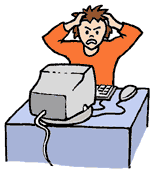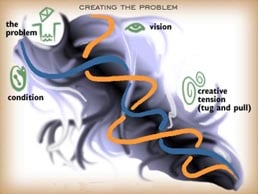* Terms and Conditions apply.


Defining closed problems involves identifying and recording all aspects of the deviation from the norm, from which you can begin to deduce the possible causes. A preliminary definition of a closed problem might be, for example, 'quality control has detected a 15% increase in rejects of component A during the past week' . This type of definition is of little help in locating the cause of such a problem, but it's a starting point for making a detailed description of the situation.

A technique widely used for defining closed problems is the Kepner- Tregoe approach, which helps to systematically analyse and define all aspects of the problem situation. Developed by Drs Kepner and Tregoe, it was used by Kepner to help find the cause of the explosion on board the Apollo space capsule in 1968, which killed three American astronauts. The cause of the accident was eventually isolated in the explosive mixture of gases used. Although this may seem an obvious place to look, bearing in mind that the lives of other astronauts could have been at risk subsequently, it was essential that every possibility of other causes or contributing factors was ruled out.

The Kepner- Tregoe approach consists of answering a series of questions about the situation, such as:
The answers help to build a detailed definition of the problem.
Without being able to investigate the situation you can only guess at answers to some of the questions, but this demonstrates how the method is used to clarify problems and to suggest possible causes.
The questions can be modified to adapt to different situations and a detailed analysis using this method would include additional questions such as
In combination, the answers to these questions build up a detailed picture of the problem which often suggests possible causes. However, when you use the Kepner-Tregoe method it's important not to jump to conclusions about the likely causes. You must complete the analysis because you locate the true cause of the problem later by testing each possibility to see if it fits all the circumstances. However, you should note any possible causes which occur to you at this stage.
When applying this method to your own problems you will need to investigate the situation carefully in order answer the questions accurately, and all the information which supports your answers should be documented so that it can be verified later. Questions may be asked repeatedly, as your understanding of the problem grows, so that you can define it more precisely.
Although the Kepner-Tregoe method is time consuming and not easy to use at first, it is worth persevering with because it ensures that you define closed problems carefully and thoroughly.
Defining open-ended problems
An open-ended problem is defined in terms of goals. Write the objectives as a statement of what you want to achieve by solving the problem. The definition needs to be precise, to give aid and direction to your search for solutions, but at the same time identify all the possible goals which would contribute your overall objective. In order to define an open ended problem try the following methods.
First to explore all the possible goals and then to define precisely those which you want achieve.
Defining the problem in terms of a 'How to ... ? statements eg 'How to finance expansion?', focuses attention on the problem area and provides a basis for suggesting alternative goals and routes to a solution.
1. Write down a preliminary definition of an open ended problem that you have faced or are facing currently. Phrase it in terms 'How to ... ?'.
2. Take as much time as you want and complete the following statements.
There is usually more than one way of looking at a problem.
You can define this one as ...
But the main point of the problem is ...
What I would really like to do is ...
If I could break all the rules and laws of reality I would try to solve it by...
The problem put in any other way could be likened to ,..
Another, even stranger way of looking at it might be ...
Now look at your original definition.. Do any of your redefinitions help you to see the problem in a different and perhaps more effective way?
If you 'tested' many different open-ended problems you would find that usually they do not have a single' correct' definition. For example, 'How to increase sales?' could be restated as
How to... make our product more saleable? increase sales outlets? improve our market share? make our marketing more effective? make our sales team more effective?
Trying to find a single all-encompassing definition severely limits the scope of possible solutions. Sometimes what appears to be a single problem is in fact a collection of several smaller, related problems.
Inaccurate or misleading definitions can result in ineffective solutions.
An effective definition accurately represents' the key features of the problem in a way which gives direction to your work in solving it,and problem situations have to be investigated thoroughly before they can be defined effectively.
The more precise the definition, the greater your chances of finding an effective solution.
Use this checklist to review how thoroughly you have defined a problem.
Open-ended problems are related to a need or desire to improve upon the current situation and there is an inevitable risk that you may fail to benefit, or even change the situation for the worse. As a safeguard against this happening you should' make a detailed comparison of the benefits of the current situation with those you will achieve by reaching your objectives. This will enable you to look for solutions which retain the good features of the current situation. You should be prepared to forfeit these only when they are clearly outweighed by the benefits of achieving your objectives. This type of analysis will also help you to measure the potential gain and estimate the practical limit of your resources in finding a solution.
Many of the techniques described for defining openended problems can be applied to defining closed problems once their cause (the obstacle) has been identified.
Defining problems effectively often requires painstaking work.You can't afford to make assumptions or dive straight into looking for a solution. Sometimes the process of defining a problem reveals that it doesn't require any action, perhaps because it will disappear and not recur, or because the actual loss or potential gain is relatively insignificant. On other occasions you may need to decide when it would be best to act.
Is action necessary, and when?
The effects of some problems are not significant enough to merit time and effort in solving them. Even when they do, because many objectives and obstacles go through phases of growth and decay, tackling a problem immediately may not be the best course of action. For example, if rain is preventing you painting your house you wait until it stops raining rather than trying to erect a huge canopy over the house. When you have a problem there are a number of options open to you, depending on the nature of the situation:
When you have decided to act upon a problem, the search for solutions involves finding ways to close the gap between your current situation and one where you will have achieved your objective. At any stage it may be necessary to redefine the problem, or you may decide that, due to new information you have acquired, ordue to a change in circumstances, the problem does not require further action.
Remember
Read the next article: Finding possible solutions